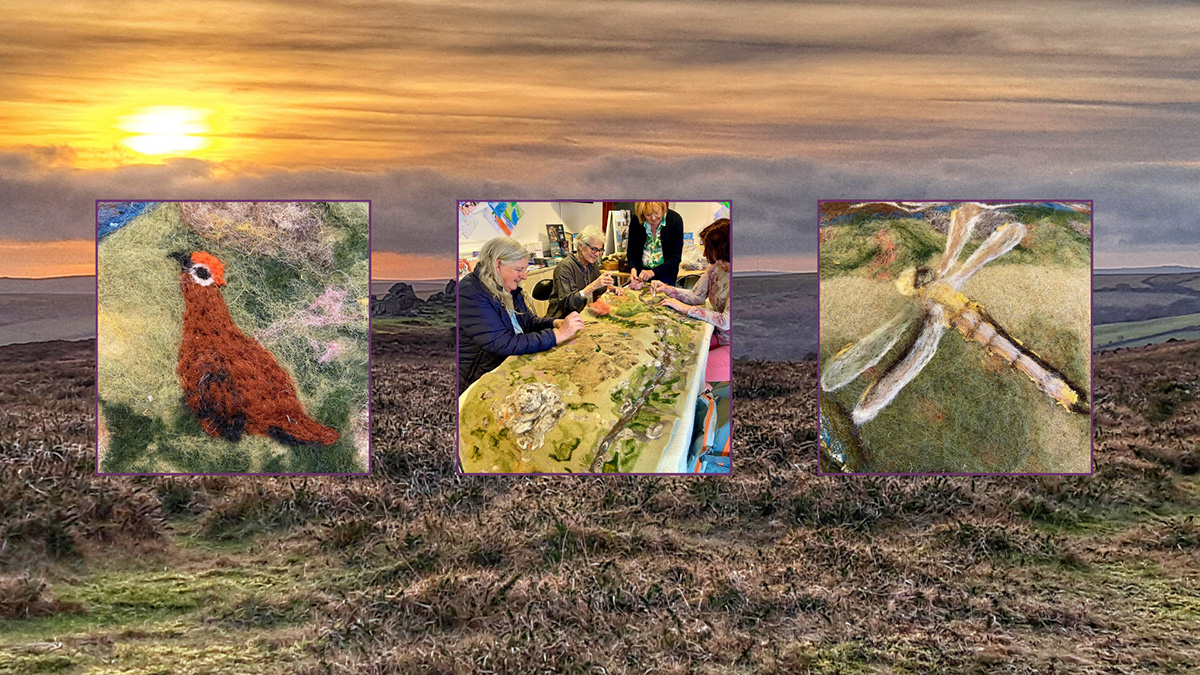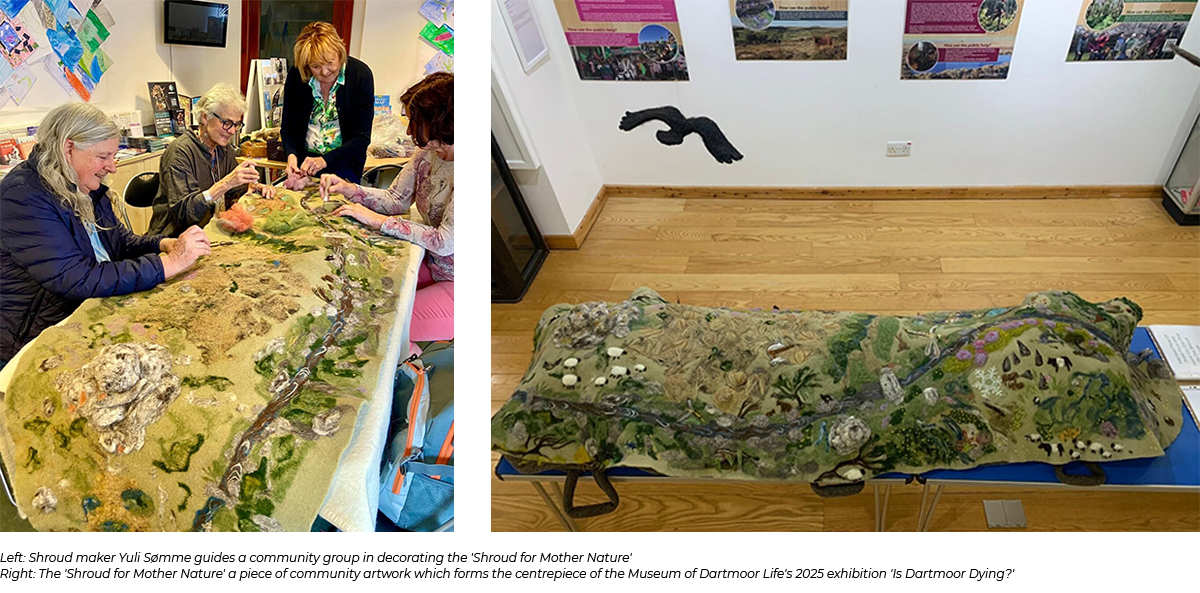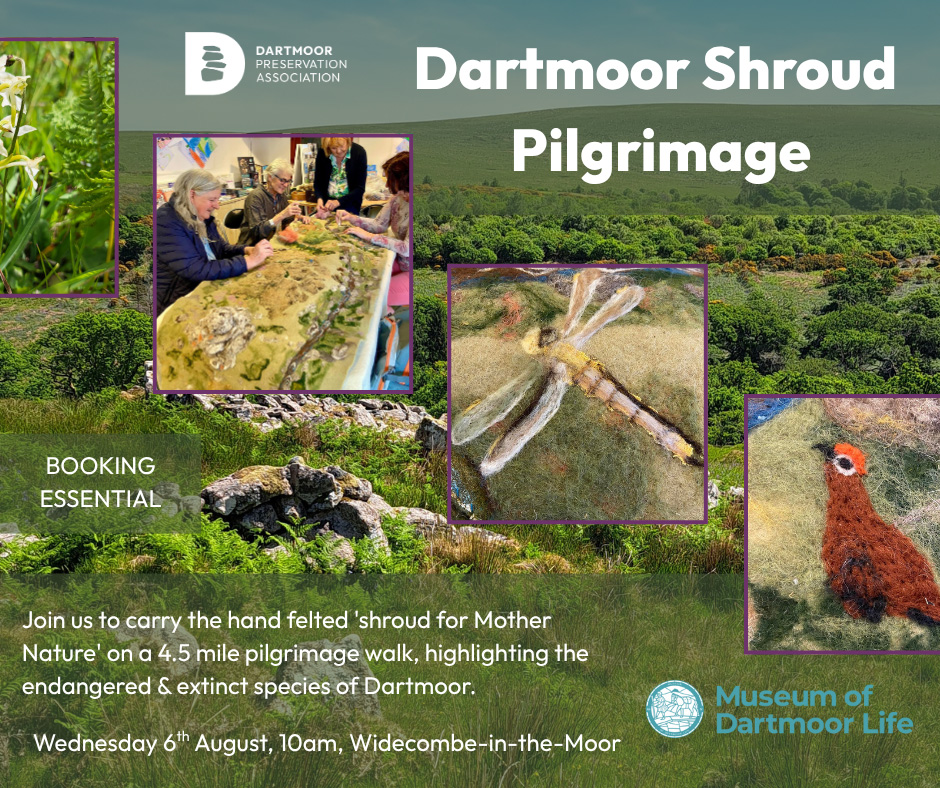An Invite to join a Pilgrimage of Reflection and Hope
The centrepiece of the Museum of Dartmoor Life’s 2025 exhibition, ‘Is Dartmoor Dying’ is the magnificent, hand felted ‘Shroud for Mother Nature’. Created by local textile artist and maker, Yuli Sømme, the woolen shroud has been lovingly created from earth-friendly organic felt and decorated with depictions of Dartmoor’s threatened and extinct plants and animals. These felt decorations have been crafted by many different people who have taken part in felting workshops at the museum, meaning the the shroud is truly a collaborative mosaic of people’s hopes and concerns for nature.

On Wednesday the 6th of August, at 10am, the DPA and the Museum of Dartmoor Life will partner to lead a pilgrimage walk beginning at the Widecombe-in-the-Moor Village Green. Locals and visitors alike are invited to join the procession and help bear the shroud on a 4.5 mile loop, which will return to Widecombe via a traditional Church Path.
This pilgrimage aims to highlight the endangered and even extinct flora and fauna of Dartmoor, many of which decorate the shroud. Starting from the Widecombe-in-the-Moor village green the route begins by climbing up a long and steep road hill, but after that becomes fairly flat and downhill at the end.

Gain an Increased Understanding of what is Happening on Dartmoor
Kristy Turner, Manager of the Museum of Dartmoor Life, says: ‘We invite you to join us and take it in turns to help carry the shroud (it does have handles) on this pilgrimage of hope. You will be rewarded with wonderful views and an increased understanding of what is happening on Dartmoor today.’
We will meet our shroud bearers on the Village Green in Widecombe at 9:30am on the 6th of August, ready to begin our pilgrimage route promptly at 10am. As we walk, experts within the group will mingle and share insights about current conservation work on Dartmoor and plans in place to support biodiversity for the future.
The physical act of carrying the shroud, moving through the landscape, which it depicts, invites reflection on the provocative question posed in the title of the exhibition; ‘Is Dartmoor Dying?’ This pilgrimage is a space for conversations around what Dartmoor needs from us and how we can step up to help this special landscape be healthy for future generations.
Those who do not wish to take part in the walk, which will cross some challenging terrain, are welcome to see the shroud off from the village green between 9:30am and 10am. All are also welcome to greet the shroud as it returns to Widecombe, at approximately 12:30pm.
Helen Bruce, Communications Officer for the DPA, says: ‘The tradition of carrying the bodies of loved ones across the moor for burial is an ancient practice, with the Lych Way and various Church Paths remaining on maps as evidence of this activity.’
‘The title of the community artwork we will be carrying in pilgrimage is deeply evocative: ‘A Shroud for Mother Nature’. This is a weighty body to carry, and a much beloved one.’
‘The DPA hope that this symbolic walk offers people the chance to pause and think about how they can make a positive impact on Dartmoor.’
Is Dartmoor Dying?
As part of the exhibition at the Museum of Dartmoor Life, local organisations, groups and charities were asked three questions, the answers to which are currently displayed on boards at the museum. Tom Usher, CEO of the DPA, gave the following responses:
1. Is Dartmoor Dying?
No, but bits of it are sick and it is at a crucial point of change in the mid 20’s of the 21st Century. Dartmoor is a complex place; history, livelihoods, people, industry, agriculture, opinions, culture, ownerships both real and perceived.
It is under threat from poor funding, a societal disconnection with the natural world, invasive species of flora, and most of all; inertia caused by competing opinions and decisions.
2. What are you doing to save it?
For 141 years the DPA has been working as an independent membership organisation to help protect and enhance Dartmoor. This has taken the form of campaigning nationally on issues of importance, advocating for public access, practical conservation work and preventing inappropriate development. We have also acquired several unique pieces of land in the National Park, to prevent them from being damaged and these are managed by our hard-working group of volunteers.
More recently we continue this work by supporting young people to use the moor through the Dartmoor Youth Rangers, Girls Do Dartmoor, our Moor Boots equipment Granting project and arguing for greater funding for National Parks, while managing our own SSSI, one of the few in favourable condition.
We maintain a strong and close relationship with the Dartmoor National Park Authority and act as their “critical friend”. Through our relationships with the authority, and partnerships with many other local organisations, we influence the formulation of policy to manage Dartmoor and participate in actions to conserve its special qualities for posterity.
3. How can the public help?
Support organisations that work on the Moor. Understand that Dartmoor is a lot more complex than it at first appears. Consider and form a view on how Dartmoor and all national parks will contribute to addressing climate change in the UK. Recognise that there are 1000s of people relying on the Moor for home and work. Develop a sense of ownership of our wild spaces. Act responsibly while on Dartmoor; dogs, litter, car speed, good sense around livestock. Take children up to Dartmoor and let them experience it early.
Places on this Dartmoor Shroud Pilgrimage are limited and must be prebooked on Eventbrite

